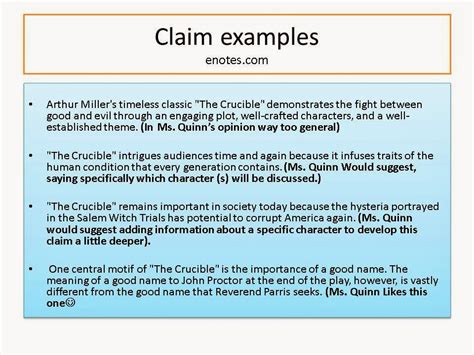Introduction

Claim, the cornerstone of any literary analysis, anchors the thesis statement and guides the entire essay’s direction. Defining a precise and defensible claim is crucial to developing a compelling argument that resonates with readers. In this comprehensive guide, we delve into the intricacies of literary claim, examining its significance, common pitfalls to avoid, and tangible benefits.
The Significance of a Precise Claim
A well-crafted claim sets the stage for a clear and focused essay. It encapsulates the central idea or argument that the writer intends to present. Without a clear claim, the essay risks straying, losing its impact, and failing to engage the reader.
Common Mistakes to Avoid
-
Overly Broad Claims: Avoid claims that are too general or all-encompassing. Such claims leave little room for specific analysis and limit the depth of the argument.
-
Unoriginal Claims: Avoid rehashing common or widely accepted opinions. Strive to present a unique and thought-provoking perspective that sets your essay apart.
-
Unwarranted Claims: Ensure that the claim is supported by sufficient evidence from the text. Assertions that lack support weaken the argument and undermine the writer’s credibility.
-
Subjective Claims: While personal interpretations are valuable, avoid basing the claim solely on subjective opinions. Literary analysis should be anchored in a scholarly and objective approach.
Benefits of a Well-Defined Claim
-
Coherence and Focus: A clear claim provides a roadmap for the entire essay, ensuring coherence and maintaining focus throughout the analysis.
-
Clarity of Purpose: It sets the expectations of the reader, allowing them to follow the argument’s trajectory and understand the writer’s intentions.
-
Enhanced Credibility: A well-supported claim establishes the writer’s authority and credibility, demonstrating a thorough understanding of the text and a capacity for critical thinking.
-
Provocative Engagement: A compelling claim invites readers to engage with the argument, fostering intellectual dialogue and stimulating critical analysis.
Table 1: Evaluating Literary Claims
| Criteria | Strong Claim | Weak Claim |
|---|---|---|
| Precision | Precise and specific | Vague or general |
| Originality | Unique and thought-provoking | Rehashed or widely accepted |
| Support | Supported by ample evidence | Lacking sufficient support |
| Objectivity | Based on scholarly and objective analysis | Based on subjective opinions |
Table 2: Common Literary Devices
| Device | Definition | Example |
|---|---|---|
| Metaphor | Implied comparison that does not use “like” or “as” | “Life is a tapestry” |
| Simile | Direct comparison that uses “like” or “as” | “Her eyes sparkled like diamonds” |
| Personification | Giving human qualities to non-human things | “The wind whispered through the trees” |
| Symbolism | An object or action that represents something else | “A rose symbolizes love” |
Table 3: Literary Analysis Process
| Step | Description |
|---|---|
| Close Reading | Carefully examine the text, annotating for key ideas and literary devices. |
| Research and Background | Gather relevant background information on the author, historical context, and critical interpretations. |
| Formulate a Claim | Develop a precise and defensible claim that reflects your analysis of the text. |
| Organize the Essay | Structure the essay logically, using paragraphs to support the claim and provide evidence. |
Table 4: Avoiding Pitfalls in Literary Analysis
| Pitfall | Description |
|---|---|
| Lack of Analysis | Only summarizing the plot or character without offering critical insights. |
| Weak Evidence | Using insufficient or irrelevant evidence to support the claim. |
| Subjectivity Bias | Allowing personal opinions to dominate the analysis, rather than relying on textual evidence. |
| Overstatement | Asserting claims that cannot be fully supported by the text. |
Conclusion
Crafting a compelling claim is the foundation of a successful literary analysis. By avoiding common pitfalls, considering the benefits, and utilizing the techniques outlined in this guide, writers can effectively communicate their arguments, engage readers, and contribute to the ongoing dialogue about literature.
